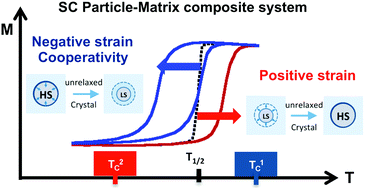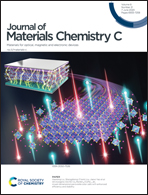Mechanical-tuning of the cooperativity of SC particles via the matrix crystallization and related size effects†‡
Abstract
We investigate the composites formed by a volume-changing material with a first-order spin transition [FeIII(3-OMe-SalEen)2]PF6, when incorporated into a matrix of 1-butanol with a combination of calorimetric and magnetic measurements. DSC evidences the multiple phase transitions of the composite and the experimental conditions to select for promoting a possibly double phase transition of 1-butanol (crystallization) on both sides of the spin transition. Cycling the compound in the liquid matrix preserves the spin-transition properties of the reference with a 1 K wide hysteresis. In contrast, the crystallization around low-spin (high-spin) particles leads to changes in the heating (cooling) branch resulting in a non-persistent (persistent) hysteresis and a positive (negative) temperature shift, as a consequence of the environmental pressure experienced by the particles. The relaxed hysteretic regime that requires the crystallization of butanol around the high-spin particles of higher volume was studied by first-order reversal curves (FORCs) technique. The particular shape of FORCs shows a cooperative mechanism and the absence of the reversible component that was previously assigned to particles–matrix elastic interactions. The first-order spin transition of a single-crystal was characterized with X-ray diffraction measurements in presence of a thin layer of 1-butanol. The temperature dependence of the volume and unit-cell parameters reproduces the changes characterizing the matrix solidification around an ensemble of low-spin (butanol coating) or high-spin (paratone coating) particles. It is also shown that the increase of cooperativity resulting from the mechanical interactions taking place in the particle–matrix system can partly counterbalance the loss of cooperativity observed when reducing the size of the spin-transition materials.



 Please wait while we load your content...
Please wait while we load your content...